The director of NASA’s Langley Research Center, Roy Bridges, says that the new Engineering and Safety Center is on track to be ready for operations on October 1, 2003. This independent centre will perform engineering assessment and testing on various NASA programs, and give employees a way to air their concerns without fear for their jobs. Staff at Langley expressed concerns that falling foam might be a risk to Columbia, but they were assured by the Johnson Space Center that the shuttle was fine – the shuttle was destroyed on re-entry killing all seven astronauts on board.
Board Reveals Why the X-43A Failed
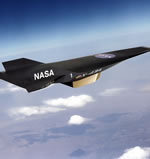
Image credit: NASA
A NASA investigation board released its findings on Wednesday that revealed why the X-34A Hyper-X prototype failed during a test on June 2, 2001. The investigators found that various miscalculations built into the prototype collectively caused the mishap. The X-34A is an experimental program to develop an air breathing hypersonic aircraft that could eventually fly up to 10 times the speed of sound. The X-34A was attached to the front of a Pegasus rocket and launched from a modified B-52 bomber. Only 13 seconds into its flight the aircraft went out of control, and was destroyed.
The NASA mishap investigation board, charged to review the loss of the X-43A Hyper-X program research vehicle during its June 2, 2001 launch, concluded no single factor or potential contributing factor caused the mishap. The flight failed because the vehicle’s control system design was deficient in several analytical modeling areas, which overestimated the system’s margins.
NASA’s Hyper-X program is developing “air breathing” engine technologies that promise performance benefits for future hypersonic aircraft and reusable space launch vehicles. In the X-43A test program, three, 12-foot long, unpiloted vehicles were planned to fly up to 10 times the speed of sound to demonstrate scramjet, or supersonic-combustion ramjet, technologies. The mishap occurred on the first of three planned flights.
For the launch, the X-43A was attached to the nose of a modified Pegasus launch vehicle, which was carried by NASA’s modified B-52 bomber. Seventy-five minutes after takeoff, at an altitude of approximately 24,000 ft., the Pegasus was released. Its solid rocket motor ignited 5.2 seconds later sending the launch vehicle and research vehicle payload on its test flight. Eight seconds later, the vehicle began its planned pitch up maneuver, which was expected to take it to an altitude of approximately 95,000 ft.
Shortly thereafter, the X-43A began to experience a control anomaly characterized by a roll oscillation. At 13.5 seconds after release and at an altitude of approximately 22,000 ft., structural overload of the starboard elevon occurred. The severe loss of control caused the X-43A to deviate significantly from its planned trajectory, and as a result, it was destroyed by range safety 48.6 seconds after release.
The mishap board found the major contributors to the mishap were modeling inaccuracies in the fin actuation system, modeling inaccuracies in the aerodynamics, and insufficient variations of modeling parameters. The flight mishap could only be reproduced when all of the modeling inaccuracies with uncertainty variations were incorporated in the analysis.
“I want to thank the Mishap Investigation Board for their comprehensive and thorough evaluation,” said Dr. Victor Lebacqz, acting Associate Administrator for NASA’s Office of Aerospace Technology. “The findings and recommendations of the board greatly enhance our opportunity for a successful second flight,” he said.
Original Source: NASA News Release
NASA Creates an Independent Safety Centre
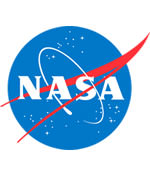
Image credit: NASA
NASA announced the creation of an independent Engineering and Safety Center (NESC) at the agency’s Langley Research Center. The 250-person division will provide independent assessment and safety review for various NASA projects and missions. The office was a response to the Columbia disaster, ideally to prevent the kind of safety problems that were uncovered by the investigation team. The team leader has yet to be announced.
NASA today announced plans to create an independent Engineering and Safety Center (NESC) at the agency’s Langley Research Center in Hampton, Va., to provide comprehensive examination of all NASA programs and projects. The center will provide a central location to coordinate and conduct robust engineering and safety assessment across the entire agency.
“Among the things we’ve learned during the investigation of the Columbia tragedy is the need to independently verify our engineering and safety standards. The new NASA Engineering and Safety center will have the capacity and authority to have direct operational influence on any agency mission,” said NASA Administrator Sean O’Keefe. “When it comes to safety and engineering analysis, we need to improve our ability to share technical information, practices and talent, and independently ensure we are in the best position to achieve mission success.”
The NESC is expected to draw on the talents of about 250 people throughout NASA and will report to former astronaut General Roy Bridges, Langley Center Director. Bryan O’Connor, also a former astronaut and Associate Administrator for the Office of Safety and Mission Assurance at NASA Headquarters in Washington, will have policy responsibility for the organization. O’Connor’s task will be to assure the effective use of all agency assets and expertise to derive the independent assessments.
“As we move forward with our ‘Return to Flight’ efforts, the development and implementation of the NESC will help us focus on the future of our technical and safety imperatives,” said O’Connor. “We have a responsibility to make our programs as safe and as sound as possible. This project raises our commitment to unprecedented levels.”
Planned activities of the new organization include:
# Independent engineering assessment and testing to support critical NASA projects and programs;
# Engineering and safety review and evaluation through independent analysis, hazard and risk assessment, safety audit, and participation in mishap investigations;
# A central location for independent trend analysis utilizing state-of-the-art tools and techniques;
# A structure to support engineering collaboration for problem resolution;
# Central coordination of engineering and programmatic lessons learned, technical standards, and technical discipline expertise; and
# Independent inspection and validation of activities to ensure the constant maintenance of NASA safety standards.
“We need to go further than what we expect to see in the findings of the Columbia Accident Investigation Board (CAIB),” added Dr. Michael Greenfield, Associate Deputy Administrator for Technical Programs at NASA Headquarters in Washington. Greenfield co-chairs the agency’s Return to Flight Team with Associate Administrator for Space Flight William F. Readdy. “We need to look beyond the CAIB and provide a centralized clearinghouse that provides NASA with authoritative and consolidated analysis and assessment for all of the agency’s high-risk endeavors,” Greenfield observed.
Original Source: NASA News Release
Measuring the Earth’s Ozone Levels with Four Satellites
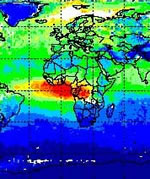
Image credit: NASA
A series of NASA satellites are measuring ozone levels in the Earth’s atmosphere with such precision that they can tell where’s it’s naturally occurring and where it’s caused by pollution. The satellites included NASA’s Terra, Tropical Rainfall Measuring Mission, Earth Probe/TOMS, and the ESA’s ERS-2 satellite, and they were able to record fires and lightning flashes around the world. Scientists were surprised to find that larger quantities of ozone over the tropical Atlantic were actually formed by lightning strikes and not pollution as originally though.
During summertime ozone near the Earth’s surface forms in most major U.S. cities when sunlight and heat mix with car exhaust and other pollution, causing health officials to issue “ozone alerts.” But in other parts of the world, such as the tropical Atlantic, this low level ozone appears to originate naturally in ways that have left scientists puzzled. Now, NASA-funded scientists using four satellites can tell where low level ozone pollution comes from and whether it was manmade or natural.
Atmospheric scientist David Edwards and his colleagues from the National Center for Atmospheric Research (NCAR) and collaborators in Canada and Europe have studied this problem using satellite data from three NASA spacecraft, one from the European Space Agency (ESA), and a computer model from NCAR. They were surprised to find that a greater amount of near-surface ozone over the tropical Atlantic develops as a result of lightning instead of agricultural and fossil fuel burning.
Their findings appeared in a recent issue of the American Geophysical Union’s Journal of Geophysical Research Atmospheres. The formation of ozone involves several factors, such as lightning and pollution from agricultural and fossil fuel burning, which is why it was helpful to use NASA’s multiple satellites to look at each in turn.
NASA satellites included Terra, the Tropical Rainfall Measuring Mission (TRMM), and Earth Probe/TOMS. ESA’s ERS-2 satellite was also used to look at ozone, and NCAR’s MOZART-2 (Model for OZone And Related chemical Tracers) computer model was used to simulate the chemical composition of the atmosphere.
Because the different satellite instruments could detect fires, lightning flashes, and the resulting pollution and ozone in the atmosphere, respectively, they provided a bird’s-eye global view of what was going on, and the computer model helped tie all the pieces together.
Fires create smoke and carbon monoxide, and lightning creates nitrogen oxides (NOx). All of these come together with other unstable compounds in a chemical soup, and sunlight helps trigger the reaction that helps form ozone. The scientists found that in the early part of the year, the intense fires set by farmers for land-clearing and traditional cultivation in north-western Africa, just south of the Sahara Desert, resulted in large amounts of pollution that they could track using satellite images as it spread over the Atlantic towards South America. This pollution greatly increased ozone at low altitudes near the fires.
However, when Edwards and his colleagues looked at areas of elevated ozone levels measured by satellites and aircraft over the Atlantic south of the equator, they were more surprised to find that this ozone was caused mainly by lightning rather than the fires.
In other parts of the world, especially near cities, ozone near Earth’s surface is often made from pollution as a result of industrial fossil-fuel burning and cars. Understanding where the pollution comes from in each case is important for improving our air quality.
NASA’s Measurements of Pollution in the Troposphere (MOPITT) instrument aboard the Terra satellite is a joint NASA/Canadian Space Agency mission that measured carbon monoxide concentrations at various levels of the atmosphere. The TOMS instrument on EP/TOMS measured tropical tropospheric ozone over the mid-Atlantic. The TRMM satellite counted the number of fires in a region using its Visible/Infrared Scanner (VIRS), and also catalogued lightning flash data from its Lightning Imaging Sensor (LIS). The satellite data was then interpreted using the MOZART-2 computer model.
Previously, scientists used TOMS observations to get a general idea of where the tropospheric ozone levels were high, but it was often difficult to say where the ozone came from and which pollution source or natural process led to its creation. Only recently has the 4 satellite combination enabled scientists to make this distinction.
This research was funded by NASA’s Earth Science Enterprise (ESE), in cooperation with the National Science Foundation, sponsor of NCAR. NASA’s ESE is dedicated to understanding the Earth as an integrated system and applying Earth System Science to improve prediction of climate, weather and natural hazards using the unique vantage point of space.
Original Source: NASA News Release
NASA Has Too Many Astronauts
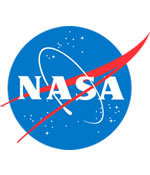
Image credit: NASA
A new report released Thursday by NASA’s Inspector General says that the agency has too many astronauts for the number of shuttle flights. As of December 2002, 53 of the agency’s 116 astronauts had yet to actually go into space because of fewer shuttle flights than originally planned; what was supposed to be 8 or 9 flights a year ended up being only five times a year. Ironically, this report was prepared before the Columbia disaster, so the loss of another orbiter will make this problem even worse. Astronauts selected for the 2004 class probably won’t make it to space until 2009.
The review “Improving Management of the Astronaut Corps” (G-01-035) has been posted to the NASA Office of Inspector General Web.
The NASA Office of Inspector General (OIG) evaluated the management of the astronaut corps. The OIG considered whether the NASA astronaut corps was being used effectively, was supportive of the Agency’s current and future mission, and was managed in accordance with governing policies and procedures. We conducted this review because the effective management of the astronaut corps is integral to the success of NASA’s mission.
Our report was scheduled to be released in final form in February 2003. However, when the Space Shuttle Columbia and its crew were lost we decided to delay the release of the report until a more appropriate time. Now that NASA is working to recruit an Astronaut Candidate Class of 2004 that includes pilots, mission specialists, and educator astronauts, we believe that our recommendations will aid the decision- making process.
Results of Review
The substance of the report has not been adjusted to reflect the loss of the Columbia or its crew. We found overly optimistic predictions of future flight rates, minimal regulation of astronaut candidate selection, and the need to staff engineering positions at Johnson Space Center to be factors in the Agency’s astronaut hiring process. As a result, costs for the astronaut program were higher than necessary and not all individuals trained to be astronauts were being used in a manner commensurate with their expensive training. We projected that the mission specialists in the class of 2000 would wait an average of 105 months to fly for the first time. Based on our projection, the last mission specialist in that class would not fly until April 2010 (116 months after joining the astronaut corps).
Recommendations
To assist the Agency in assuring that the size of the corps is more closely aligned with mission and program needs, we recommended that the Agency establish formal guidelines for certain aspects of the astronaut candidate selection process, conduct more realistic analyses of astronaut corps size needs, document reasons for deviating from those analyses, and establish formal criteria for astronaut technical assignments.
Management’s Response
NASA management concurred with our recommendations and has planned corrective actions that we consider responsive.
Original Source: NASA News Release
NASA Shuffles Shuttle Management Team
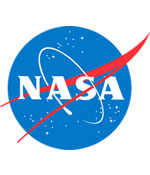
Image credit: NASA
NASA removed several managers from the space shuttle team on Wednesday as part of its response to the Columbia accident investigation. The manager for the vehicle engineering office was reappointed to a similar position at the Langley Research Center, while the head of the mission management team and manager of systems integration appear to have just been let go. NASA also named new candidates who will fill the positions.
Space Shuttle Program Manager Bill Parsons today announced several key leadership changes within the office as it reorganizes and evolves following the Columbia accident.
?This is a critical time for the agency and the shuttle program and I believe these changes and additions to my staff prepares us to return to flight as soon as possible and, most importantly, as safely as possible,? Parsons said.
N. Wayne Hale, Jr., is named Acting Deputy Manager, Space Shuttle Program. He will return to the Johnson Space Center from the Kennedy Space Center where he has served as Manager, Launch Integration, since February.
Hale joined NASA JSC in 1978 and has served in several senior technical and managerial positions. He began his managerial career in 1985 as Head, Communications Systems Section. From 1988 to 2002 he served as a flight director including the Ascent and Entry Flight Director for 28 Space Shuttle flights. He earned his Bachelor of Science in Mechanical Engineering in 1976 from Rice University and a Master of Science degree in Mechanical Engineering in 1978 from Purdue University.
Steve M. Poulos, Jr., becomes Acting Manager, Orbiter Project Office at JSC. He joins the shuttle program from the Engineering Directorate where he most recently was Chief, Crew and Thermal Systems Division.
Poulos joined NASA JSC in 1989 and has held positions including Deputy Chief, Extravehicular Activity (EVA) Equipment Branch, and Chief, EVA and Spacesuit Systems Branch in the Engineering Directorate; Deputy Manager, EVA Project Office; and Deputy Manager, Program Integration Office, International Space Station Program. He earned his Bachelor of Science in Metallurgical Engineering in 1982 from Penn State University and a Master of Business Administration in 1992 from the University of Houston ? Clear Lake.
Edward J. Mango becomes Deputy Manager, Orbiter Project Office. He has been the technical assistant to the Space Shuttle Program Manager on detail from the Kennedy Space Center.
Mango joined NASA at the Kennedy Space Center in 1986 and has held positions that include Lead Project Engineer for the External Tank and Solid Rocket Motors; Lead Project Engineer for Atlantis during the Shuttle-Mir Program; Shuttle Project Engineer; and Shuttle Launch Manager. Most recently he served as the Recovery Director for the Columbia debris recovery effort in East Texas. Mango earned his Bachelor of Science in Aerospace Engineering in 1981 from Parks College of Saint Louis University and a Master of Science in Engineering from the University of Central Florida in 1993.
John P. Shannon is named Acting Manager, Flight Operations and Integration. Most recently, he served as Lead Flight Director on Discovery?s STS-102 mission in March 2001. Following Columbia?s accident, Shannon served as the Deputy Director of the Columbia Task Force that served as the interface between NASA and the Columbia Accident Investigation Board.
Shannon joined NASA JSC in 1987 and has served in several senior technical and managerial positions. He began his managerial career in 1992 as Head, Guidance and Control Systems Section. From 1993 to 2003 he served as a flight director, including Ascent and Entry Flight Director for 11 Space Shuttle flights. He earned his Bachelor of Science in Aerospace Engineering in 1987 from Texas A & M University. In 2002 he was selected to participate in the inaugural class of the JSC Leadership Development Program. In addition, he has been selected to attend the Harvard Program for Management Development through the NASA Fellowship Program.
John F. Muratore is named Manager, Systems Integration Office. He most recently was Assistant to the Director of Engineering at JSC.
Muratore joined NASA JSC in 1983 and has held positions including Chief, Reconfiguration Management Division, Space Shuttle Flight Director, and Chief, Control Center Systems Division in the Mission Operations Directorate; and Associate Director and Deputy Manager, Advance Development Office within the Engineering Directorate. He earned his Bachelor of Science in Electrical Engineering in 1979 from Yale University and a Master of Science in Computer Science in 1988 from the University of Houston – Clear Lake.
Original Source: NASA News Release
Helios Crash Investigation Begins
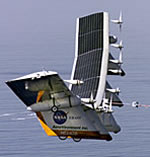
Image credit: NASA
NASA has recovered 75% of the solar-powered Helios aircraft after it crashed into the Pacific Ocean off the coast of Hawaii last week. Researchers say that the unmanned prototype was at an altitude of only 900 metres when it experienced control problems which shook the aircraft violently and caused it to crash. Unfortunately, none of the recovered debris can be reusable because of damage from the salt water. This was its tenth test flight.
As much as 75 percent, by weight, of the Helios Prototype solar electric airplane that crashed into the Pacific Ocean June 26 has been recovered from the waters several miles west of the Hawaiian island of Kauai.
The Helios Prototype is part of a NASA Dryden Flight Research Center project to develop unmanned aerial vehicle (UAV) technologies to enable UAVs to perform a variety of long-duration missions including environmental monitoring and telecommunications relay services. Helios was built and operated by AeroVironment, Inc. of Monrovia, Calif.
Researchers said the 247-ft. remotely piloted flying wing aircraft, operating on solar cell power, was at about 3,000 feet in restricted Navy test range airspace when it experienced control difficulties that resulted in severe oscillations before Helios sustained some structural damage and went down. AeroVironment’s solar aircraft team has previously conducted nine successful flights with the Helios Prototype and more than 40 on predecessor solar aircraft. NASA has convened a mishap investigation board on Kauai to determine the cause of the crash.
Among debris recovered with the help of the U.S. Navy?s Pacific Missile Range Facility and the Niihau Ranch were the two hydrogen fuel tanks carried by Helios in a quest to validate fuel cell electric power technology for airborne applications. Helios team members say none of the recovered pieces will be reusable because of damage and salt-water contamination. They say the crash does not pose environmental hazards. Formal recovery efforts ended on June 28, but debris patrols of the beaches on the west side of Kauai continue.
Solar Aircraft Lost Over the Pacific
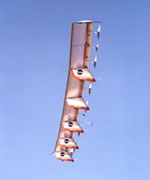
Image credit: NASA
NASA’s remotely piloted Helios aircraft was destroyed on Thursday when it broke up over the Pacific Ocean near the Hawaiian Islands. The Helios is a large flying covered with solar cells which is designed to fly at very high altitudes for very long durations – it broke the world altitude record when it reached 29,500 metres in August, 2001. In the future, fleets of these aircraft could replace the services of satellites for a fraction of the cost. The cause of the accident isn’t known.
The remotely operated Helios Prototype aircraft, a proof-of-concept solar-electric flying wing designed to operate at extremely high altitudes for long duration, was destroyed when it crashed today during a checkout flight from the U.S. Navy?s Pacific Missile Range Facility (PMRF) on the Hawaiian island of Kauai.
There was no property damage or injuries on the ground resulting from the accident. The remotely piloted aircraft came down within the confines of the PMRF test range over the Pacific Ocean west of the facility. Cause of the mishap is not yet known.
The solar-electric, propeller-driven aircraft had been flying under the guidance of ground-based mission controllers for AeroVironment, Inc., of Monrovia, Calif., the plane?s builder and operator. The lightweight flying wing had taken off from PMRF at about 10:06 a.m. on a functional checkout flight and had been aloft for about 29 minutes over the PMRF test range when the mishap occurred. The mishap occurred during a shakedown mission in preparation for a long-endurance mission of almost two days that had been planned for next month.
The Helios Prototype is one of several remotely piloted aircraft whose technological development has been sponsored and funded by NASA under the Environmental Research Aircraft and Sensor Technology (ERAST) program, managed by NASA?s Dryden Flight Research Center, Edwards, Calif. Current to power its electric motors and other systems was generated by high-efficiency solar cells spread across the upper surface of its 247-foot long wing during the day and by an experimental fuel cell-based electrical system at night. The Helios Prototype was designed to fly at altitudes of up to 100,000 feet on single-day atmospheric science and imaging missions, as well as perform multi-day telecommunications relay missions at altitudes of 50,000 to 65,000 feet.
The Helios Prototype set a world altitude record for winged aircraft of 96,863 feet during a flight from the Navy facility at Barking Sands, Kauai, in August 2001.
An accident investigation team will be formed by NASA and supported by AeroVironment and the U.S. Navy to determine the exact cause of the Helios Prototype mishap.
Original Source: NASA News Release
James Kennedy New Director for Kennedy Space Center

Image credit: NASA
James M. Kennedy was selected by NASA today as administrator of the agency’s Kennedy Space Center (KSC) in Florida. Prior to this assignment, Kennedy was the deputy director of NASA’s George C. Marshall Space Flight Center in Huntsville Alabama, and served as a project manager for the X-34 and DC-XA projects. He first joined NASA in 1968 and has received numerous awards during his tenure with the space agency.
William F. Readdy, Associate Administrator for Space Flight at NASA Headquarters in Washington, today named James W. Kennedy as the new Director of the agency’s Kennedy Space Center (KSC) in Florida. Kennedy has served as KSC’s Deputy Director since November 2002. He will succeed General Roy Bridges, who was appointed to lead NASA’s Langley Research Center, Hampton, Va., June 13.
“Along with his impeccable credentials, Jim brings stability to KSC at a time when we need it,” Readdy said making the announcement. “As we prepare to implement the findings of the Columbia Accident Investigation Board, Jim’s knowledge of the Space Shuttle and his leadership abilities are essential in making our ‘Return to Flight’ effort a success,” he said.
Prior to his assignment to KSC in 2002, Kennedy was deputy director of NASA’s George C. Marshall Space Flight Center in Huntsville, Ala.
Kennedy also served as project manager for major initiatives, such as the X-34 and the DC-XA, and he led the One NASA effort to help make the agency more effective and efficient by encouraging teamwork across all field centers. In early 1996, he was the manager for Marshall’s Space Shuttle Projects Resident Office at KSC. Kennedy returned to Marshall when he received a Senior Executive Service appointment in September 1996 and was named manager of the Solid Rocket Booster Project.
In 1998, he was selected as the Deputy Director of Science and Engineering, where he was responsible for establishing and maintaining a nationally recognized research and development capability in space research and technology. One year later, he became the Director of Engineering.
“Jim is the right person we need at the helm of the Kennedy Space Center, as we prepare to return to safe flight,” added NASA Administrator Sean O’Keefe. “He’s a distinguished engineer and a devoted public servant. I know his colleagues at KSC will give Jim their full support, and I am confident, under his guidance, the center will meet and exceed all the objectives facing us in the coming months,” O’Keefe said.
Kennedy first joined NASA in 1968 in the Aerospace Engineering Cooperative Education program at KSC. He earned a bachelor’s degree in mechanical engineering from Auburn University, Ala., in 1972. After being called to active duty in the U.S. Air Force, he earned his master’s degree in business administration from Georgia Southern University, Statesboro, in 1977.
Kennedy has received numerous awards during his NASA career, including Marshall’s Leadership Award, NASA’s Silver Snoopy Award, a Distinguished Service Medal and a Meritorious Rank Award. He also has received a Group Achievement Award and several Special Service and Performance Awards. In 2003, Kennedy received the National Space Club’s Astronautics Engineer of the Year Award.
Original Source: NASA News Release
Columbia Investigators Analyze NASA Culture
Investigators into the Columbia disaster believe they understand the events that led to the destruction of the shuttle, that falling foam created a crack in a critical heat shield. Now they’re looking into the culture and management in NASA to find out how to prevent problems from happening in the future. The accident investigation board said that fully half of their report will include will deal with management problems at NASA that could affect flight safety. The board hopes their recommendations will create a sense of urgency to help the agency create a safer replacement for the aging space shuttle.
